N.H.S. Reorganisation 1982
Formation of Northamptonshire Ambulance Service - Chief Ambulance Officer: - Mr M. Tarry F.A.S.I.
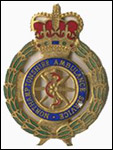 |
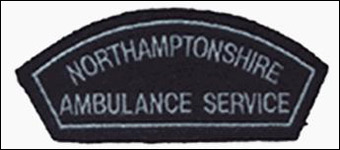 |
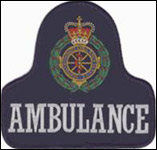 |
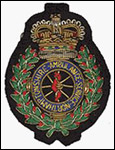 |
|
Cap Badge, Shoulder Flash and Breast Badge of the new Service
|
Cap Badge 1990
|
In 1982, there was a further reorganisation of the Health Service, which saw the disbanding of Area Health Authorities and the formation of District Health Authorities. Fortunately, the Ambulance Service was left as a
County
Service
, providing Service to both Health Districts.
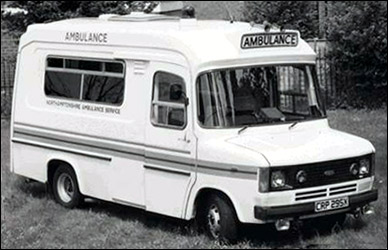 |
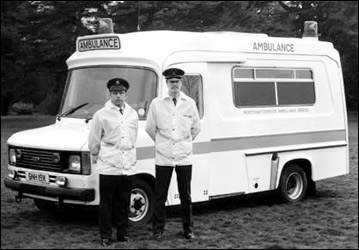 |
|
Ford Transit Ambulance introduction of Blue flashing lights on the front. John Harley and Tom MacFarlane circa 1982
|
1982
The Northampton Veteran Ambulance Society was formed in November 1982 in order to buy a Veteran Ambulance with a view to restoring it to its original condition. A suitable vehicle was located through an advertisement.
Some of the members of the Society visited the town of
Wem
in
Shropshire
to inspect the Ambulance, which we subsequently purchased and brought to
Northampton
on
18th December 1982
.
The Ambulance we now own is an
Austin
"Big 6" manufactured in 1938. It has an unladen weight of 1 ton 12cwt and came complete with a number of spares.
The interior bears a plaque saying that it was converted by a company called Thomas Startin Jnr, a firm that is still trading today (1984). It was originally a Rolls Royce works Ambulance at
Derby
and
Crewe
and remained there until 1970 when someone working in their drawing office purchased it.
Its last owner had renovated many old vehicles and he drove the Big 6 to
Turkey
in 1972.
|
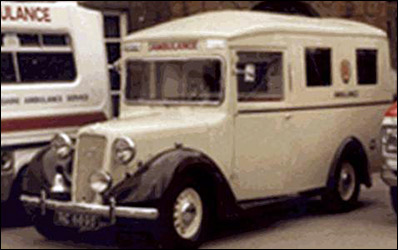 |
The Ambulance is now completely renovated; we use it to raise funds for its continued preservation and the purchase of specialised equipment for the Ambulance Service and local Hospitals.
The majority of our members are professional Ambulance personnel serving in
Northampton,
mainly at Mereway Ambulance Station.
If you feel you would like to know more about or support this Society in any way please contact the Society C/O Mereway Ambulance Station Mereway Northampton.
1985 Ambulance Services Twinning
For many years we have heard of Cities, Towns and Villages twinning with their opposite numbers all over the world.
On
the 18th February 1985
the Northamptonshire Ambulance Service made its own piece of history by being the first Ambulance service to twin with a European service.
The twinning was with the G.G. - G.D. Ambulance Service of Amsterdam, who are the Municipal Ambulance Service for the City.
After the twinning an organisation was formed known as The Anglo - Dutch Ambulance Association, with an aim of staff exchange, whereby two or three Dutch colleagues came over each month. Giving them the chance to live and work along side their colleagues in Northamptonshire, this also gave members in the County a chance find out about the Dutch way of life.
On the 18th September 1987 another historical milestone was achieved, the twinning of the Anglo - Dutch Ambulance Association with the DUK Ambulance Service in
Karlsruhe
which is in the south of
Germany
. From that day the Association had to change its name to the Star of Life International thereby giving a chance to link up with other Countries.
From these exchange visits any lasting friendships have been born.
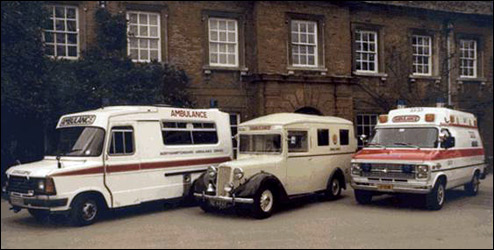 |
Northamptonshire Ambulance circa 1985
Northampton Veteran Ambulance circa 1938
Dutch Ambulance circa 1985
|
The Ambulance Service in Northamptonshire provides for a rural County with a population of approximately 540,000 covering 585,000 acres. It is a long thin County stretching from
Lincolnshire
in the north to Oxfordshire in the southwest. The Service is responsible for transporting all patients in medical need to Hospital and in 1984 the Service conveyed a total of 237,834 patients and covered 1,483,404 miles. It is worth remembering that only 13,766 of these patients are actual emergencies and the others are patients being conveyed to
Day
Hospitals
and Outpatient clinics.
The present cost is approximately £2.5 million per year to provide this Service.
Staffing
There is a total of 176 road staff and officers and a further 23 officers and staff in the Headquarters and Training Departments.
Premises
The Ambulance Service Headquarters and Central Control are situated at
39 Billing Road,
Northampton
and there are Ambulance Stations at Brackley, Corby, Daventry,
Kettering,
Mereway, St James,
Harborough Road,
Northampton,
Oundle, Rushden, Towcester and Wellingborough.
Radios
All vehicles are fitted with radio and are centrally controlled via remote radio sites at Potcote, near Towcester and Broughton near
Kettering.
There are radio links in the two
District
General
Hospitals
at
Kettering
and
Northampton
, which provides radio facilities for staff, and doctors at the scene of an incident anywhere in the County, to contact any department within Hospital for advice and guidance.
Portable radio equipment is used at the scene of major incidents, high rise block of flats etc. which keeps staff in direct contact with Central Control at all times.
Ambulance vehicles
There are a total of 75 vehicles in Northamptonshire which comprise 50 front line Accident Ambulances and 45 sitting case type vehicles, 15 of which are fitted with tail-lift to assist patients who are unable to climb steps.
The Service is honoured and proud to possess a complete fleet of Ford Transit vehicles and the staff take good pride in their vehicles. Regular servicing is carried out and is strictly controlled and the number of breakdowns is extremely small.
1985
Control of the Service
All requests for Ambulance transport, both Emergency and non-Emergency, are routed to the Central Control room where an experienced Ambulance officer is always on duty. He is able, in addition to despatching the quickest Ambulance, to offer advice on a patient's care until the arrival of the Ambulance. The Control room is responsible for arranging for approximately 1,000 patients per day between Monday and Friday and for the Emergency journeys during the night and weekend periods.
The Control room is now situated at the Ambulance Headquarters in
Billing Road
Northampton
after the previous locations at County Hall and Northampton House. The Service has also developed the most advanced computer systems in the country, pioneered by Mr Eric Porter of Cleric Computer Services Ltd Congleton, Cheshire, for patient scheduling, management information, vehicle maintenance and staffing records etc. and this is being implemented by other Ambulance services in the
United Kingdom
.
Training
Before a person is appointed to the Service he/she is required to successfully complete a series of examinations and driving tests.
New entrants to the service are recruited as Day staff to provide care and transport for many of the non-Emergency patients. Their training consists of a three-week induction course where they are taught Emergency aid techniques, First aid etc and are required to successfully complete a two-week driving course in the first year of service.
Millar Trained Ambulance Personnel
When vacancies occur in the shift rotas it is considered a promotion for a Day worker to become a Fully Qualified Ambulance man/woman. To do this he/she is required to attend a six-week advanced training course, at the Trent Regional Ambulance Training Centre. Markfield is situated on the edge of
Charnwood
Forest
, near
Leicester, and again requires he/she must successfully pass a number of examinations at the end of the course.
Refresher Training
Fully qualified Ambulance personnel are required to attend the
Regional
Ambulance
Training School
for two weeks refresher training every five years, in order update and refresh the many skills required of a modern Ambulance person.
Officer Training
There are many courses that officers attend in Control, management, industrial relations, Health and Safety Work, and many other subjects. Some of these carried out locally; others are carried out at specialist training Centres and universities.
1985
Looking to the Future
It is necessary for today's Ambulance Personnel to be highly trained to meet the ever-changing medical scene.
Medical advances during the last 10 years in the treatment of heart conditions, renal failure and ever-increasing sophistication of drug therapy, the Ambulance person’s task more demanding. In addition to the medical scene, the number of impact road accidents is becoming more horrible particularly on the Ml motorway, requiring not only their Ambulance Aid efficiency but also demands a standard of driving skills.
At the present time the service is looking to an extension of the Ambulance personnel’s training skills and is also considering a review of the Ambulance equipment that is carried.
M TARRY F.A.S.I.
Chief Ambulance Officer
| NORTHAMPTONSHIRE AMBULANCE SERVICE |
|
The figures set out below are the statistics of the Service from January 1984 to December 1984. |
|
Patients |
|
Total patients conveyed 237,834 |
|
This figure is broken down by type of patient: |
|
Emergency patients (999) conveyed 13,766 |
|
Non Emergency patients conveyed 223,504 |
|
Patients conveyed by rail 564 |
|
Mileages |
|
Total mileage covered 1,483,404 |
|
This figure is broken down by type of mileage: |
|
Emergency mileage 201,758 |
|
Non Emergency mileage 1,242,925 |
|
Rail journey mileage 38,721 |
|
Total cost of the service at present is £2.5 million per annum |
| 1985 |
Rank Structure |
|
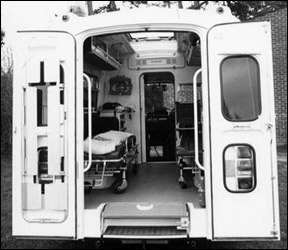 |
|
Front Line Emergency Ambulance
(Note the York trolleys, Lairdel aspirator) Entanox, Oxygen Equipment, Short spinal boards were in use.
|
|
|
Chief Ambulance Officer |
|
|
Assistant Ambulance Officer |
|
|
Chief Controller |
|
|
Control Officer |
|
|
Training Officer |
|
|
Assistant Controller |
|
|
Ambulance Liaison Officer |
|
|
Station Officer |
|
|
Leading Ambulanceman |
|
|
Control Assistant |
|
|
Qualified Ambulanceman |
|
|
Day Ambulanceman |
|
|
Trainee Ambulanceman |
|
1986 -1990
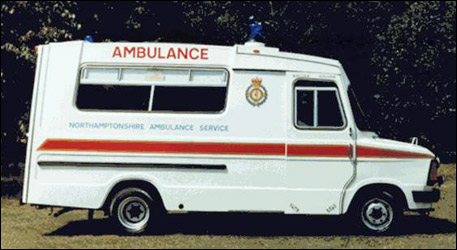 |
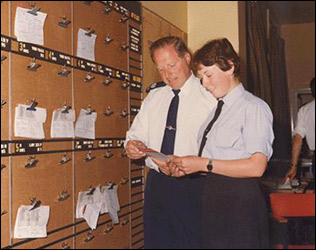 |
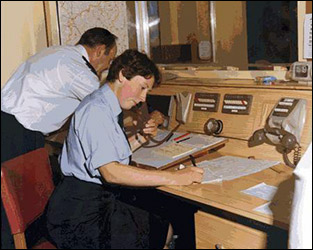 |
|
Ford Transit circa 1986
|
John Sturgess and Control Assistant Headquarters and Control, Billing Road Northampton circa 1986
|
Bill Yule and Control Assistant (on the Storno radio) Control Room at 39 Billing Road circa 1986
|
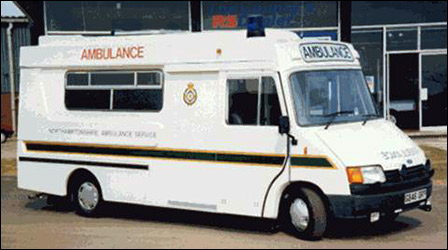 |
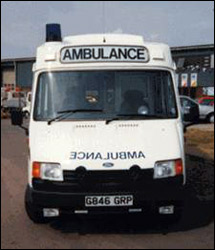 |
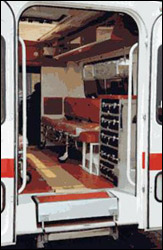 |
Ford Transit Ambulance 1989
New interior layout
Note the style of cases on the right
|
| A Brochure was prepared in 1990 ready for the N.H.S. internal market. |
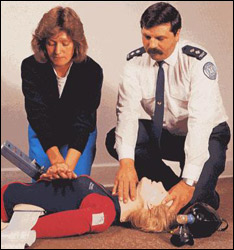 |
(l) Our advanced training programmes are open to other professionals and members of the public
Andy
Westley teaching Resuscitation
(r) Professional transportation of the elderly and the disabled for the reassurance and peace of mind of relatives and friends
|
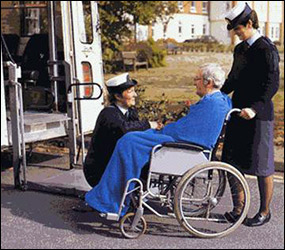 |
 |
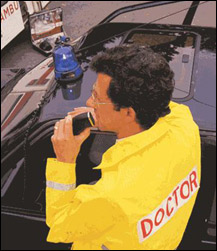 |
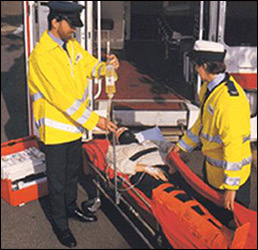 |
(l) Our uniquely reliable Communications System helping the professionals keep in touch. Dr Alan Sutton GP Road Accident Scheme
(r) Expert application of intravenous fluids, cervical collar and Box leg splint to ensure quality Emergency care
(below) Left to right Ian Civil, Jonathen Stevens, and Andy Westley, Assistant Training Manager
|
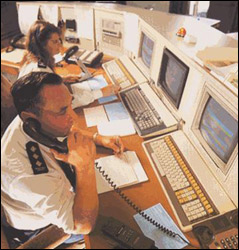 |
(l) Dave Winchcombe and Jackie Bennett, Dave Winchcombe and Jackie Bennett, using the new Intelligent Terminal Radio System, our Control Room and Communications Officers working 24 hours a day 365 days a year to ensure we respond quickly and correctly to your needs. using the new Intelligent Terminal Radio System, our Control Room and Communications Officers working 24 hours a day 365 days a year to ensure we respond quickly and correctly to your needs. |
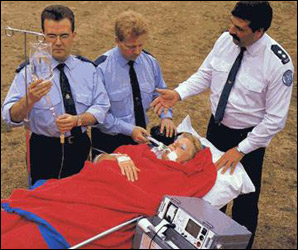 |
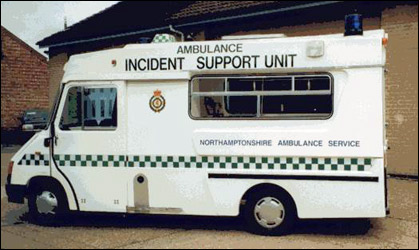 |
This vehicle was a forward Control and Ambulance equipment carrier. The Radio equipment provided a UHF (Silver Control) forward link to Handportable radios and a VHF (Gold Control) rear link to the main Control Centre.
The Radio’s can be worked from vehicle Batteries, Mains electric or Portable generator.
The spare Ambulance equipment carried was Blankets, Canvass carrying sheets, Dressings, Folding stretchers, Drugs, Protective clothing, and Lantern batteries.
|
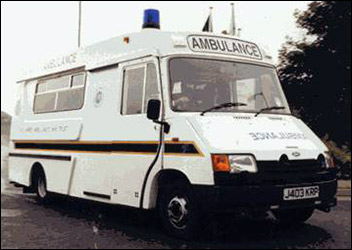 |
|
Mobile Incident Support Unit circa 1990
|
Ford Transit Ambulance circa 1991
|
1992
Application for N.H.S. Trust Status
Effectiveness of a National Health Service Trust
It is the belief of the management team that the additional freedoms and opportunities available to Trusts will enable the services to plan and provide for a more effective utilisation of resources giving enhanced benefits to patients. Recognition of the need to become a more patient led organisation is established and both management and staff are committed to the acceptance of change, ensuring that those sections of the service directly responsible for patient care are given the highest priority.
Creation of the Two Shires Trust
The submission of an application for National Health Service Trust status requires the two Ambulance Services to come together under a single management framework over a period of time.
This merger is seen as a beneficial way forward for the future and will ensure that the Trust has strength and enhanced financial viability to meet the demands of a changing environment.
It is recognised that Ambulance staff will play an important part in maintaining the existing high standards of patient care whilst the services are going through this transition.
 |
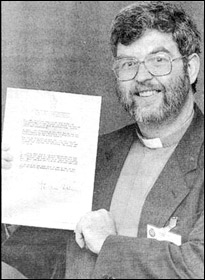 |
Rev Ian Lowell became the first Ambulance Chaplain in
Britain
and was
Commissioned as Chaplain to Northamptonshire Ambulance Service
19 October 1992.
|
The Management Team 1987 - 1993
The Management Team is composed of highly motivated, qualified and experienced individuals. The Management structure is shown below.
|
|
Ambulance Executive Management Board
|
|
|
|
Chief Ambulance Officer
|
|
|
|
Deputy Chief Ambulance Officer
|
|
|
Control |
Field Management |
Training |
Headquarters |
|
Control and Control Communications
and Computer Manager |
Staff Officer Field Management |
Staff Officer Training Manager |
Staff Officer Headquarters Support |
|
Control Shift Managers |
Group Station Managers |
Assistant Training Manager |
Clerical Officers |
|
Planning Manager |
Leading Ambulance |
|
|
|
Liason Managers |
Ambulance Para-medic |
|
|
|
Control Assistants Grade 2 |
Ambulance Technician |
|
|
|
Control Assistants Grade 1 |
Ambulance Person |
|
|
The present Ambulance Service structure permits the flow of expertise or personnel across units according to patient need.
Advisory Groups 1987 - 1993
The Management Team, are advised by professional groups on clinical and technical aspect of health care, fleet management, and financial aspects of the Ambulance Service.
The Ambulance Executive meets every three months and is composed of the Northampton District Assistant General Manager, the Chief Ambulance Officer, the two Assistant District Financial Directors and Kettering District Senior Nurse Planner.
The Ambulance Management Board consisting of the Chief Ambulance Officer, Deputy Chief Ambulance Officer, Chief Control, Communications and Computer Manager, Staff Officer Field Management, Staff Officer Headquarters Support, and the Staff Officer Training, meet at regular intervals.
The total Staffing for the Northamptonshire Ambulance Services is as follows :-
|
|
Total
|
W.T.E
|
|
Headquarters Establishment |
8
|
5.34
|
|
Control Establishment |
25
|
24.5
|
|
Field Operational Establishment |
217
|
196.06
|
|
Training Department Establishment |
2
|
2
|
|
Car Service Establishment |
30
|
30
|
|
|
Domestic Services Establishment |
10
|
2.95
|
|
TOTAL STAFFING FOR 1992/93 |
292
|
260.85
|
Headquarters
The Ambulance Headquarters is responsible for the administration of the Service through the Chief Ambulance Officer.
Some of the functions are Management, Administration, Operational Monitoring, and generally overseeing the Ambulance Service.
Staffing
The Staffing for the Northamptonshire Ambulance Service (Headquarters) is as follows :-
|
|
Total
|
W.T.E.
|
|
Chief Ambulance Officer |
1
|
1
|
|
Deputy Chief Ambulance Officer |
1
|
1
|
|
Staff Officer Field Management |
1
|
1
|
|
Staff Officer Headquarters Support |
1
|
1
|
|
Administrative Assistants |
3
|
1.34
|
|
1992/93 Total Headquarters Establishment |
7
|
5.34
|
Control and Communications
Well over half a million people rely on our Service to respond to emergency, urgent and non-urgent calls.
The complex demands of patient movement in the
Northampton
and Kettering Health Authority areas, which form our County, require expert planning and controlling.
Our planning and computer systems have been developed through experience and so, with advanced equipment, expert operators and of course the help of our staff, we are able to ensure that the right support is at the right place at the right time.
Staffing
The Staffing for the Northamptonshire Ambulance Service (Control and Communications) is as follows :-
|
|
Total
|
W.T.E.
|
|
Control Communications and Computer Manager |
1
|
1
|
|
Control Shift Managers |
6
|
6
|
|
Planning Manager |
1
|
1
|
|
Control Assistants Grade 2 |
10
|
10
|
|
Control Assistants Grade 1 |
2
|
2
|
|
Northampton General Hospital |
|
|
|
Ambulance Liaison Manager |
1
|
1
|
|
Control Assistants Grade 1 |
2
|
1.5
|
|
Kettering
General
Hospital
|
|
|
|
Ambulance Liaison Manager |
1
|
1
|
|
Control Assistant Grade 1 |
1
|
1
|
|
1992/93 Total Control Establishment |
25
|
24.5
|
Field Operations
Our National Health Service activities of ferrying people who are sick, weak or elderly to and from hospital are well known.
Our Service is structured to ensure we can fulfil the variety of demands put upon us.
The uniformed men and women who come to the scene of an incident or who arrive to pick up, say, an elderly relative for out-patient, care are not all the same.
We also offer a first class Ambulance Service that is available privately, and we are happy to be commissioned by sports clubs and other event organizers, or by individuals.
Staffing
The Staffing for the Northamptonshire Ambulance Service (Field Operations) is as follows:
|
|
Total
|
W.T.E.
|
|
Northampton District Ambulance Stations Emergency |
89
|
89
|
|
Kettering District Ambulance Stations Emergency |
79
|
79
|
|
Northampton District Ambulance Stations Non-Emergency |
25
|
16.38
|
|
Kettering District Ambulance Stations Non-Emergency |
24
|
11.68
|
|
1992/93 Total Field Operational Establishment |
217
|
196.06
|
Ambulance Car Service
The Ambulance Car Service is used on a voluntary basis and the only remuneration paid is on a mileage basis, this mileage allowance is less than the Hospital Car Service allowance, it is used mainly for long distance journeys.
The NHS Patients Carried and Mileage travelled for the Northamptonshire Ambulance
Car Service is as follows :-
|
Total NHS Patients carried 1992/93 |
21748 |
|
Total mileage travelled 1992/93 |
483887 |
Staffing
The Staffing for the Northamptonshire Ambulance Car Service is as follows :-
|
|
Total
|
W.T.E. |
|
1992/93 Total Car Service Establishment |
30
|
30
|
Training Department
Training is provided on a residential basis at
Regional
Ambulance
Training Schools
for Paramedics, Ambulance Aid, Driving, Management, and many other specialist subjects.
4 Department of Health Instructors, 2 Department of Health Driving Instructors, and 5 in-service instructors carry out in-Service training in our own Training Department.
Subjects are as follows :-
In-service induction training, First Aid Certificated training, First Aid refresher courses, Driving assessments, Cardiac Monitoring, Management courses, Resuscitation Courses, Kinetics of lifting, Awareness courses of paramedic skills, Annual assessments of paramedic skills
Staffing
The Staffing for the Northamptonshire Ambulance Service (Training Department) is as follows :-
|
|
Total
|
W.T.E.
|
|
Staff Officer Training Manager |
1
|
1
|
|
Assistant Training Manager |
1
|
1
|
|
1992/93 Total Training Department Establishment |
2
|
2
|
Support Services
A VHF radio network is operated covering Northamptonshire with 3 VHF channels in order to communicate with Ambulances, Officers, and Ambulance Stations and in emergencies,
Northampton
and
Kettering
General
Hospitals
.
G.P. Road Accident Doctors cars have been fitted with VHF radios for emergency use.
A Wang computer is used for Patient Registration, Enquiries, Abortive Journeys, Work planning, Statistics, Transmission of work to Stations, Radio messages. Vehicle utilisation, Personnel records, Fleet Maintenance, Budget and Staff hours monitoring, and many other tasks. This system was pioneered by Mr Eric Porter of Cleric Computer Services Ltd in Congleton Cheshire.
The Ambulance Liaison Departments at
Kettering
and
Northampton General
Hospitals
have computer terminals in order to access the Wang computer at the Ambulance Control. This access is by B.T. telephone line with the use of a modem and Patient Registration is carried out with this system.
The Ambulance Stations have telephone modems and printers to enable the computer at the Ambulance Control to transmit the daily work schedules to the staff.
Fleet Management
Vehicles
The vehicles for the Northamptonshire Ambulance Service are as follows :-
|
Conventional Ambulance (AMB) |
34
|
|
Dual Purpose Vehicle (DP) |
1
|
|
Sitting Case Vehicle (SCV) |
14
|
|
Sitting Case Vehicle Tail Lift (TL) |
14
|
|
Incident Support Vehicle (ISV) |
1
|
|
Cars |
2
|
|
1992/93 TOTAL VEHICLES |
66
|
Vehicle distribution
|
Northampton District |
AMB
|
DP
|
SCV
|
TL
|
ISV
|
CAR
|
Total
|
|
Northampton North |
6
|
|
2
|
3
|
|
|
11
|
|
Northampton South |
5
|
|
|
2
|
|
1
|
8
|
|
Daventry |
3
|
|
2
|
2
|
|
|
7
|
|
Towcester |
1
|
|
|
1
|
|
|
5
|
|
Brackley |
3
|
|
2
|
|
|
|
5
|
|
District Total |
19
|
|
6
|
8
|
|
1
|
33
|
|
|
|
|
|
|
|
|
|
|
Kettering District |
|
|
|
|
|
|
|
|
Corby |
3
|
|
1
|
2
|
|
1
|
6
|
|
Kettering |
5
|
|
3
|
1
|
|
|
10
|
|
Oundle |
1
|
1
|
1
|
|
|
|
3
|
|
Wellingborough |
5
|
|
2
|
2
|
|
|
9
|
|
Rushden |
2
|
|
1
|
1
|
1
|
|
5
|
|
District Total |
16
|
1
|
8
|
6
|
1
|
1
|
33
|
|